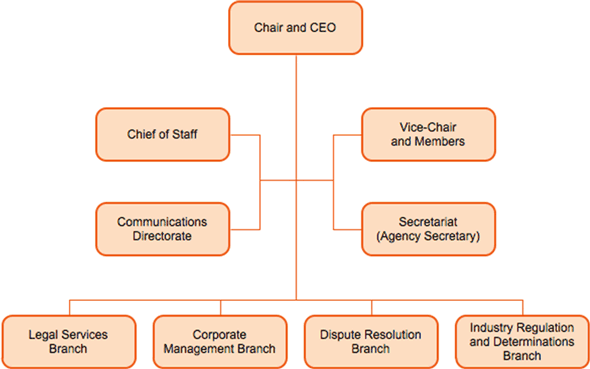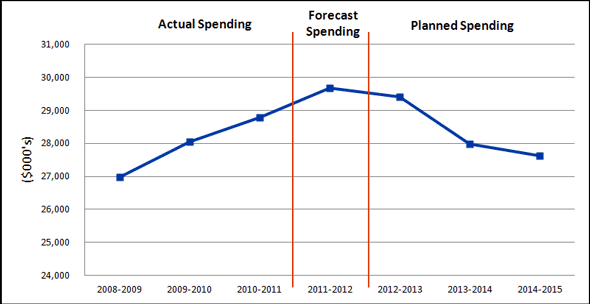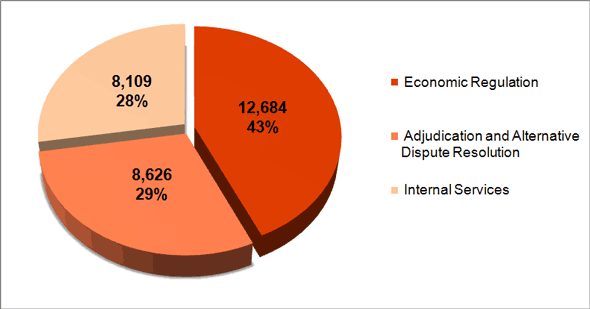Common menu bar links
Breadcrumb Trail
ARCHIVED - Canadian Transportation Agency - Report
 This page has been archived.
This page has been archived.
Archived Content
Information identified as archived on the Web is for reference, research or recordkeeping purposes. It has not been altered or updated after the date of archiving. Web pages that are archived on the Web are not subject to the Government of Canada Web Standards. As per the Communications Policy of the Government of Canada, you can request alternate formats on the "Contact Us" page.
Message from the Chair and Chief Executive Officer
I am pleased to present the Canadian Transportation Agency's Report on Plans and Priorities for 2012-2013. This report outlines how the Agency will continue to support a competitive and accessible national transportation system that fulfils the needs of Canadians and the Canadian economy.
Thanks to its first-ever three-year Strategic Plan, completed in fiscal year 2010-2011, the Agency has made great strides in becoming a more efficient, forward-looking and client-focused organization.
The Agency builds on these successes in its new Strategic Plan for 2011-2014. This plan takes into account the evolving Canadian and global transportation sector, the requirement to limit the administrative burden on the parties we regulate, the needs and expectations of transportation users and service providers, as well as our operating environment.
Now entering its second year, the plan focuses our efforts on three strategic priorities:
- Client services. We will invest in relationships with our clients and stakeholders while continuing to build more effective, responsive and efficient dispute resolution processes;
- Regulatory regime renewal. We will modernize the Agency's suite of essential regulations and ensure that its administration is effective, streamlined and user-friendly; and
- People. We will act to maintain a sustainable, expert workforce and a supportive workplace, with the understanding that engaged, knowledgeable and competent employees are critical to the Agency's ability to provide quality services.
Common to all three priorities is our ongoing commitment to open dialogue and engagement with our clients, stakeholders and employees. In fact, feedback from our extensive outreach activities and Client Satisfaction Survey program helped us to develop our new Strategic Plan objectives and to set challenging performance targets that will enable us to track progress over the coming years.
The new Strategic Plan also reflects input from staff at all levels of the Agency. In particular, the People priority implements recommendations from internal employee working groups on how to make the organization an even better place to work by improving trust, conflict resolution, new employee orientation and career development.
The year 2012-2013 represents the midpoint of this Strategic Plan. Over the next twelve months, the Agency will consolidate the initiatives launched the previous year, while initiating other projects that support its Strategic Plan objectives.
First and foremost, the Agency will continue to ensure that it uses resources effectively and efficiently. The Agency will also seize opportunities to enhance online service provision and re-engineer business processes to gain efficiencies and achieve further service improvements. Regulatory activities and dispute resolution services will also be assessed to ensure that they are effective, fully justify the expenditure of public funds and result in the greatest possible overall economic and public benefit. And ultimately, the Agency will continue to contribute to the achievement of a fair and secure marketplace.
As we continue to build on our existing strengths and implement our new strategic objectives, I am confident that the Agency will maintain its reputation as a respected and trusted tribunal and economic regulator that meets the needs of all Canadians.
Geoffrey C. Hare
Chair and Chief Executive Officer
Section I: Overview
Raison d'être and Responsibilities
The Canadian Transportation Agency is an independent administrative body of the Government of Canada. It performs two key functions within the national transportation system:
- as a quasi-judicial tribunal, the Agency, informally and through formal adjudication, resolves a range of commercial and consumer transportation-related disputes, including accessibility issues for persons with disabilities. It operates like a court when adjudicating disputes; and
- as an economic regulator, the Agency makes determinations and issues authorities, licences and permits to transportation carriers under federal jurisdiction.
By administering transportation regulations and providing dispute resolution services, the Agency ensures that transportation users, commercial shippers and individual travellers receive the protection provided for them in the legislation. It also ensures that carriers meet regulatory requirements before engaging in transportation activities. In doing so, the Agency sets and continuously strives to achieve high performance standards.
The Agency offers a number of dispute resolution services, ranging from facilitation to mediation, arbitration and formal adjudication. The Agency strives to ensure that its services are effective, responsive, fair and transparent, and that it weighs the interests of all parties in the national transportation system in a balanced manner.
Education and consultation are integral to the Agency's effectiveness in carrying out its mandate. The Agency works closely with transportation service users, providers and other affected stakeholders. It helps travellers, shippers, carriers and others to fully understand not only their rights and obligations under the Canada Transportation Act, but also the Agency's roles and responsibilities.
The Agency exercises its powers through its Members, who are appointed by the Governor in Council (GIC): the GIC may appoint up to five full-time Members, including the Chair and Chief Executive Officer (CEO), and the Vice-Chair. The Minister of Transport, Infrastructure and Communities can also appoint up to three temporary Members.
The Chair and CEO is accountable for the Agency's three program activities. The Vice-Chair replaces the Chair and CEO during his absence. All Agency Members, as independent decision-makers, are accountable for making quasi-judicial decisions and determinations on matters before the Agency.
The Agency's organizational structure is composed of four branches: the Dispute Resolution Branch, the Industry Regulation and Determinations Branch, the Legal Services Branch and the Corporate Management Branch. The heads of each branch, as well as the Communications Directorate and the Secretariat, report directly to the Chair.
The Agency's headquarters are located in the National Capital Region. Agency personnel working in field offices in six cities across Canada carry out air and accessibility enforcement activities. The Agency's role and structure[1] are described on its Web site.
Parliament funds the Agency through an operating expenditures vote. The Agency operates within the context of the very large and complex Canadian transportation system.[2]
Strategic Outcome and Program Activity Architecture
The Agency reports its plans, priorities and expected results to Parliament on the basis of its Program Activity Architecture (PAA). The PAA explains how the program activities and allocation of resources contribute to the Agency's strategic outcome.
Strategic Outcome:
Transparent, fair and timely dispute resolution and economic regulation of the national transportation system
This is achieved through three program activities:
| Program Activities | Expected Results |
|---|---|
| Economic Regulation | Economic and other interests of transportation users, service providers and other affected parties are protected through timely and effective intervention |
| Service providers (air, rail and marine) comply with regulatory requirements | |
| The Canadian National Railway Company (CN) and the Canadian Pacific Railway Company (CP) are provided with the information required to ensure they do not exceed the maximum grain revenue entitlements for the shipment of western grain | |
| Adjudication and Alternative Dispute Resolution | Access to a specialized dispute resolution system that is transparent, fair and timely |
| Internal Services | Support the needs of programs and other corporate obligations of the Agency |
Organizational Priorities
| Priority | Type | Link to Strategic Outcome |
|---|---|---|
| Client services | Previously committed to | Transparent, fair and timely dispute resolution and economic regulation of the national transportation system |
| Supporting Program Activities | ||
|
Adjudication and Alternative Dispute Resolution Internal Services |
||
| Status | ||
|
This priority will result in the Agency's dispute resolution services being of high quality, and its clients being well informed and served in a fair, responsive and timely manner. Why is this a priority? The improvement and modernization of our dispute resolution services will respond to:
Plans for meeting the priority The Agency has adopted an ambitious three-year plan to:
|
||
| Priority | Type | Link to Strategic Outcome |
|---|---|---|
| Regulatory regime renewal | Previously committed to | Transparent, fair and timely dispute resolution and economic regulation of the national transportation system |
| Supporting Program Activity | ||
| Economic Regulation | ||
| Status | ||
|
This priority will result in the Agency's regulatory and non-regulatory approaches and their administration being up-to-date, well understood and delivered effectively. Why is this a priority? The modernization of the regulatory regime and its administration will respond to:
Plans for meeting the priority The Agency has adopted an ambitious three-year plan to:
|
||
| Priority | Type | Link to Strategic Outcome |
|---|---|---|
| People | Ongoing | Transparent, fair and timely dispute resolution and economic regulation of the national transportation system |
| Supporting Program Activities | ||
|
Economic Regulation Adjudication and Alternative Dispute Resolution Internal Services |
||
| Status | ||
|
This priority will result in Agency employees who are more engaged, innovative, knowledgeable and client-oriented. They will have the necessary tools and technology to enable them to conscientiously and competently fulfil the Agency's mandate. Why is this a priority?
Plans for meeting the priority The Agency has adopted an ambitious three-year plan to:
|
||
Risk Analysis
The Agency's corporate risk profile is a critical step in implementing an integrated approach to risk management. The Agency has developed a three-year corporate risk profile, which describes the three key risk areas that impact its service delivery. These risks are directly related to the Agency's program activities and strategic priorities.
| Risk | Link to Strategic Priorities | ||
|---|---|---|---|
| Client service | Regulatory regime renewal | People | |
| Loss of reputation as a respected and trusted tribunal and economic regulator | X | X | |
| Resource reductions and constraints | X | X | X |
| Loss of business critical knowledge, information and expertise | X | X | X |
Loss of reputation as a respected and trusted tribunal and economic regulator
The Agency is committed to maintaining its reputation as a respected and trusted tribunal and economic regulator that contributes to a competitive and accessible national transportation system. This reputation is based on the Agency's independence from outside influence, its impartiality, the integrity and timeliness of its procedures, its expertise in transportation and human rights matters, and the deference that the Federal Court of Appeal and the Supreme Court of Canada have given to its past decisions. In order to maintain its reputation, the Agency must continue to be attentive to these aspects in its role as a quasi-judicial administrative tribunal.
Providing timely and high quality service is a core value of the Agency and it demonstrates this commitment through the expertise and professionalism of its staff and by being responsive to its clients and stakeholders. To ensure this is continuously achieved, the Agency must measure client satisfaction to improve service delivery; promote ongoing dialogue with employees, clients and stakeholders to address their concerns; uphold high standards for client service; ensure decisions are justified, intelligible and transparent; and ensure that regulations, guidelines and codes of practice remain current and responsive to changing needs.
Resource reductions and constraints
As a demand-driven organization with a mandate dependent upon supporting and advancing an economically efficient and accessible national transportation system, the Agency must also ensure it is able to respond in a timely manner to changes in government policy, the external environment, and the Agency's legislative mandate. The Agency must be alert to significant changes in these areas so that it can quickly respond to and meet client and stakeholder expectations while respecting the Agency's available resources and capacity.
The Agency continues to adjust to the full implications of additional responsibilities related to legislative amendments, which include the ongoing development of an approach to rail noise and vibration complaints, increased focus on alternative dispute resolution, and the development of new regulations regarding air services price advertising. The Agency closely monitors shifting workload demands and re-allocates its staff and budget resources where needed. It will also continue to ensure that it uses its resources effectively and efficiently by seizing opportunities to enhance online service provision, re-engineering business processes, and modernizing its regulatory framework.
Loss of business critical knowledge, information and expertise
The retention of knowledge and expertise is critical to maintain and enhance the level of service already provided, and to adapt to additional responsibilities. The changing demographics of the Agency's workforce present a significant challenge in human resource management. Over the next few years, the Agency risks losing significant corporate knowledge and specialized expertise as many long-term and key employees retire. In order to continue supporting its mandate, the Agency will focus its efforts on recruiting, developing, and retaining highly competent staff and to ensure that knowledge and expertise are retained and transferred.
The competitiveness of today's labour market requires employees to acquire and update skill sets that allow them to reach their full employment potential. This may create a movement of human resources away from the Agency, and can result in the loss of invaluable and sometimes irreplaceable corporate knowledge and expertise. The Agency continues to emphasize the development of a wide range of skills, abilities and knowledge among its employees to minimize the loss when employees leave the organization. It has identified the areas most vulnerable to the loss of critical business knowledge and expertise, and works to ensure knowledge transfer and succession planning, and to develop and maintain comprehensive procedures/manuals for retention of corporate knowledge.
Planning Summary
| 2012–2013 | 2013–2014 | 2014–2015 |
|---|---|---|
| 29,419 | 27,977 | 27,622 |
| 2012–2013 | 2013–2014 | 2014–2015 |
|---|---|---|
| 257 | 256 | 256 |
| Performance Indicators | Targets |
|---|---|
| Percentage of overall satisfaction with the quality of Agency service delivery | 70% |
| Percentage of discretionary rulings overturned by the Federal Court of Appeal or the Supreme Court of Canada on the basis of procedural fairness | 0% |
| Percentage of formal decisions published on the Agency's Web site within one business day | 95% |
| Program Activity | Forecast Spending 2011–2012 | Planned Spending | Alignment to Government of Canada Outcomes | ||
|---|---|---|---|---|---|
| 2012–2013 | 2013–2014 | 2014–2015 | |||
| Economic Regulation | 13,095 | 12,684 | 12,198 | 12,133 | A fair and secure marketplace |
| Adjudication and Alternative Dispute Resolution | 8,611 | 8,626 | 8,124 | 7,974 | A fair and secure marketplace |
| Total Planned Spending | 21,706 | 21,310 | 20,322 | 20,107 | |
| Program Activity | Forecast Spending 2011–2012 | Planned Spending | ||
|---|---|---|---|---|
| 2012–2013 | 2013–2014 | 2014–2015 | ||
| Internal Services | 7,969 | 8,109 | 7,655 | 7,515 |
Expenditure Profile
The overall increase in spending of $1.8 million from 2008-2009 to 2010-2011 is mainly attributable to the cost of collective bargaining for various employee groups and other salary-related items.
Forecast spending for 2011-2012 and 2012-2013 are also higher than previous years but the increase is mainly attributable to the reimbursement by Treasury Board Secretariat for the payout of severance pay and termination benefits related to the latest collective agreements.
For the 2013-2014 to 2014-2015 periods, the total planned spending is lower than previous years as we consider that the majority of the payouts for severance pay and termination benefits related to the latest collective agreements will have been made. In real terms, the Agency's reference levels have remained virtually the same since 2008-2009.
($ thousands)[3]
The Agency's total planned spending for 2012–13 is $29.4 million. Seventy-two percent of planned spending is directed at the Agency's two program activities that directly support the strategic outcome. The balance of 28 % is allocated to internal services.
Estimates by Vote
For information on our organizational appropriations, please see the 2012-2013 Main Estimates Publication[4].



